#Cretaceous South America
Text
Udelartitan celeste Soto et al., 2024 (new genus and species)

(Type tail vertebrae of Udelartitan celeste, from Soto et al., 2024)
Meaning of name: Udelartitan = UdelaR [acronym for the Universidad de la República] titan [in Greek]; celeste = sky blue [in Spanish, referring to the nickname of Uruguayan teams in international sport competitions]
Age: Late Cretaceous (exact age uncertain)
Where found: Guichón Formation, Paysandú, Uruguay
How much is known: Multiple tail vertebrae and some limb bones. It is unknown how many of these bones belonged to the same individuals.
Notes: Udelartitan was a titanosaurian sauropod and one of the few Mesozoic dinosaurs known from Uruguay. Most known specimens of Udelartitan had been briefly described in 2012, but were left unnamed at the time. It may have been closely related to Alamosaurus from the southwestern United States, Baurutitan from Brazil, and Pellegrinisaurus from Argentina, with which it shares the feature of having a frontmost tail vertebra that is convex on both ends.

(Schematic skeletal of Udelartitan celeste with bones known from the type specimen in green and those known from other specimens in red, from Soto et al., 2024)
Reference: Soto, M., J.L. Carballido, M.C. Langer, J.C.G. Silva Junior, F. Montenegro, and D. Perea. 2024. Phylogenetic relationships of a new titanosaur (Dinosauria, Sauropoda) from the Upper Cretaceous of Uruguay. Cretaceous Research advance online publication. doi: 10.1016/j.cretres.2024.105894
109 notes
·
View notes
Photo
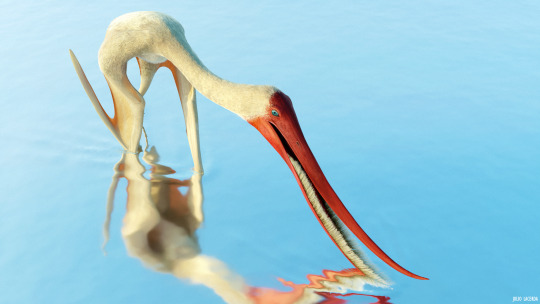
Pterodaustro
Patreon • Ko-fi • Facebook • Twitter • Prints & Merch
729 notes
·
View notes
Text

Dinovember Day 19: Argentinosaurus.
#Argentinosaurus#dinovember#dinovember2022#sauropod#dinosaur#cretaceous#dinosaur art#dino art#titanosaur#argentina#south america#traditional art#digital art#deceitful art#technically an old piece that i just touched up a bit.
140 notes
·
View notes
Text
Here is the male tupandactylus design

Feel free to be inspired an even use this design
just tag me if you do pls
#tupandactylus#tupandactylus imperator#HOLY SHIT#I JUST SAW A JUVENILE TURKEY VULTURE#I THINK#FLYING REALLY LOW NEXT TO MY WINDOW#holy fuck#that was crazy#anyways#pterosaur#tapejarid#tapejaridae#crestaceous#Cretaceous#cretaceous period#early cretaceous#krato formation#Brazil#south america#south eastern Brazil#paleontology#paleoart
8 notes
·
View notes
Text
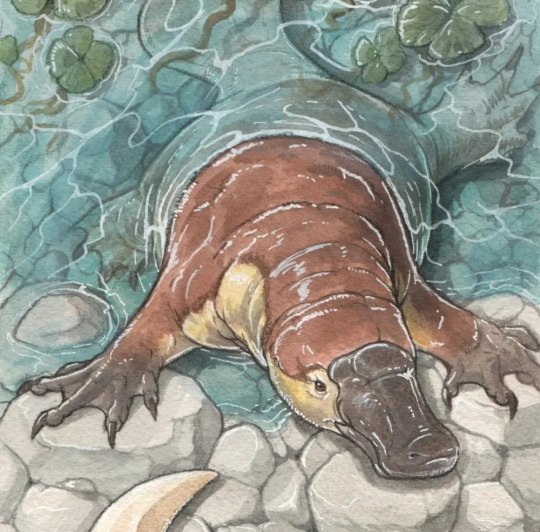
Patagorhynchus
Patagorhynchus — вимерлий рід однопрохідних (Monotremata) ссавців з крейди Південної Америки. Єдиний та типовий вид — Patagorhynchus pascuali. Рід описаний в 2023 році та на момент свого опису є першим відомим родом зубатих однопрохідних ссавців з крейди суперконтиненту Гондвана.
Повний текст на сайті "Вимерлий світ":
https://extinctworld.in.ua/patagorhynchus/
#platypus#mammal#monotremata#art#cretaceous#paleoart#gondwana#south america#cretaceous period#ua#paleontology#prehistoric#prehistory#extinct#ukraine#animals#article#daily#fossils#ukrainian#мова#українська мова#україна#тварини#patagorhynchus#usa
53 notes
·
View notes
Text
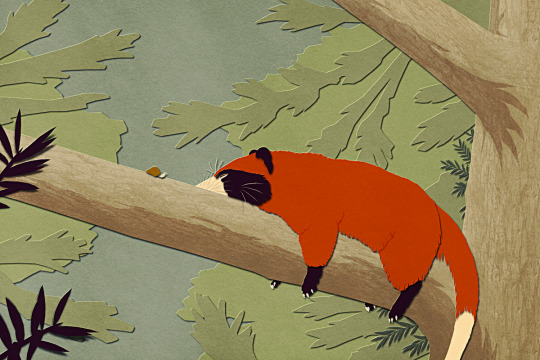
Although most Mesozoic mammals were rather small, a few different lineages produced some pretty hefty-sized forms – most notably the metatherian Didelphodon, the gondwantherians Adalatherium and Vintana, and the eutriconodont Repenomamus.
And now we've got another one to add to that list.
Patagomaia chainko lived towards the end of the Cretaceous, about 70 million years ago, in what is now Patagonia near the southern tip of South America. Known from some partial leg and hip bones, it was potentially the largest known Mesozoic mammal yet discovered – estimated to have been similar in size to a modern bobcat, roughly 50cm tall at the shoulder (~1'8") and weighing around 14kg (~31lbs).
Distinctive anatomical features of the bones indicate it was an early therian mammal, the group that contains both modern marsupials and placentals, but it can't currently be classified any more specifically than that. Mesozoic therian fossils are very rare in the southern continents, so Patagomaia's presence in late Cretaceous South America adds to their known range and diversity, as well as providing an example of surprisingly large body size for the time.
Without more material it's impossible to tell what Patagomaia's ecology was. I've gone for a fairly generic life appearance here, and while what's known of its joints and muscle attachments doesn't indicate climbing specializations, plenty of unexpected tetrapods still like to get up on tree branches.
———
NixIllustration.com | Tumblr | Patreon
#science illustration#paleontology#paleoart#palaeoblr#patagomaia#theria#mammal#mesozoic mammal#art#big mesozoic mama#truly one of the most mammals of all time
332 notes
·
View notes
Photo
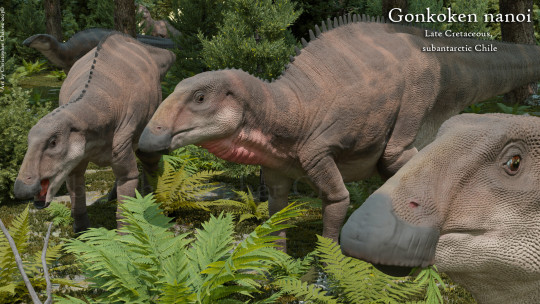

Chilean paleontologists have released their findings on a new duck-billed dinosaur named Gonkoken nanoi, which inhabited Chilean Patagonia in the late Cretaceous, in the late age of the Dinosaur, approximately 70 mya.
The name Gonkoken nanoi means similar to koken or swan in Tehuelche language, the indigenous people that inhabited the region where this species was found, and nanoi in honort to Mario “Nano” Ulloa, who helped during expeditions. It is estimated that it could have measured between 3.5 and 4 meters in length and weighed between 600 kilograms and one ton.
Chilean Patagonia could have been a refuge for these primitive forms of hadrosaurs, which would have migrated to the Southern Hemisphere long before more advanced forms, and it is believed these hadrosaur may have even reached Antarctica, when it was connected to South America.
3D Reconstruction by Christopher Chávez
Reference (Open Access): Alarcón-Muñoz et a., 2023. Relict duck-billed dinosaurs survived into the last age of the dinosaurs in subantarctic Chile. Science Advance
#new species#dinosaur#hadrosaur#Gonkoken nanoi#sciblr#science blr#science#biology#archaeology#fossil#gonkoken
530 notes
·
View notes
Text
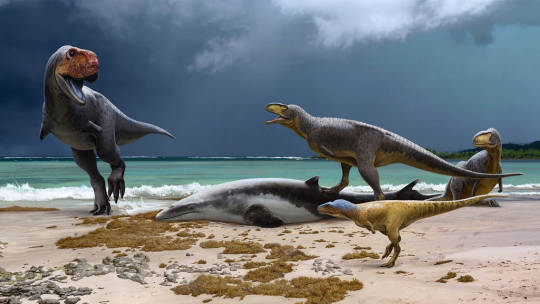
[ Artistic reconstruction of three abelisaurids recently discovered in Morocco, illustrated by Andrey Atuchin. ]
"Fossils of two newly discovered carnivorous dinosaurs have been found in Morocco. The animals lived at the end of the Cretaceous period just before the mass extinction event 66 million years ago, and show dinosaurs were diverse in Africa before going extinct.
Both predators belong to a primitive family known as abelisaurids. These dinosaurs were bipedal theropods with very short, vestigial arms (even shorter than Tyrannosaurus rex) and short bulldog-like snouts.
Among the most famous abelisaurids is the two-horned Carnotaurus which would have been about 8 metres in length.
While North America and east Asia were dominated by tyrannosaurine giant predators like T. rex and Tarbosaurus, abelisaurids were widespread across Africa, south Asia, Madagascar and South America.
One of the new Moroccan abelisaurids was found in Sidi Chennane, just outside Casablanca. It is known from a fossilised shin bone which suggests a medium-sized carnivore about 5 metres long.
The other was found at Sidi Daoui, also near Casablanca, but would have been much smaller at about 2.6 metres in length.
Both are described in a paper published in the journal Cretaceous Research."
Read more: "T. rex cousins discovered in Morocco shed light on last dinosaurs in Africa" by Evrim Yazgin.
#palaeoblr#Palaeontology#Paleontology#Dinosaurs#Theropods#Morocco#Article#Prehistoric#Mesozoic#Cretaceous#Extinct#Art
208 notes
·
View notes
Text
Did you Know
Mammal bias isn't the only one when it comes to researching nature and deep time?
There are more!
There is also time bias! As I have discussed with @quark-nova, Essentially, because the more recent something is the easier it is to learn about - more remains of things, more details from the rocks, etc. - we also have ridiculous amounts of bias towards more recent times. This is clearest when it comes to the traditional geologic time scale - the further back you go, the longer time periods are, and nothing is divided particularly evenly. I would even say the "anthropocene" is the biggest offender in this - if we zoomed out from today to a hundred million years ago, all of the extinctions and chaos of the past 2.5 million years would get lumped together into one big mass extinction, not separated out into nitty gritty and frankly narcissistic time slices.
Then there is geographical bias! You'd think people studying the whole biosphere wouldn't have this, but we do! Thanks to *colonialism!* The geologies of North America and Europe are significantly better studied than the rest of the world, which is fighting hard to catch up. This even extends to our knowledge of modern life, with many new species still being discovered in "the global south" (I personally prefer the term Gondwana, but what can you do). And we have no one to blame for that but ourselves.
And another one is land bias! Because we are land organisms, we tend to think about land ecosystems more than oceanic ones - in fact, the ocean only really gets enough time on it in the early stages of life, everything before the Silurian, because there isn't a land ecosystem to focus on more! But the oceans are just as influential in our past - honestly, moreso - than land ecosystems, even today - think about how much El Niño affects us all! But how many people know about the end cretaceous extinction, and not the mesozoic marine revolution? How many people know that reefs at the end Cretaceous were just, made by bivalves for some reason? The list goes on.
Then there's the one most people know about already - megafaunal and charismatic bias! This often goes hand in hand with mammal bias, but essentially, because we ourselves are megafauna - I know we specifically define megafauna to exclude humans, but how the hell is that logical - we operate on a big scale, at any rate - we tend to favor megafauna in our knowledge of the past and our understanding of life. And, if its not megafauna, it at least has to be charismatic - cute, extra weird maybe, or familiar. This affects modern research so much, especially conservation and research funding - not just paleo, but also neontological work. Charismatic Megafauna get everything, and everyone else gets scraps.
This is just the tip of the iceberg! All scientists bring in bias - that's why we need as many scientists as possible, so we have as many perspectives as possible to come up with the most parsimonious and universal view of nature - but some biases are fairly universal for humans and need to be murdered in our heads by all of us. Why did Wingspan and Holotype both start with North America when the best birds are in South America and the best fossil dinosaurs are in Asia? The list is infinite.
The biases we have because of the way history has played out, the way preservation works, and because of what kind of organisms we are as humans, are ones we all have to work to disassemble and deconstruct in our brains. The more we do so, the more we can look at the big picture, understand our entire biosphere, and work together to protect it.
Plus, imagine how much cool stuff we'll learn about when we finally take the time to do so.
We have nothing to lose but our chains.
306 notes
·
View notes
Text
Prehistoric Planet Croc Ideas
So this was a thing I did on Twitter in anticipation of Prehistoric Planet. Obviously crocs (in this case meaning crocodylomorphs) were a pretty massive part of earth's fauna during the late Cretaceous, and seeing as the first season featured NONE I came to speculate which taxa could hypothetically make an appearance.
Now part of the challenge for myself was to come up with a new, interesting contender every day in anticipation of the show's release, each based around the confirmed episides we had and restricted purely to taxa from the Campanian and Maastrichtian. While it took a lot of energy, I did manage to do so. Hell, halfway through they dropped the reveal of Simosuchus, which I had saved for later.
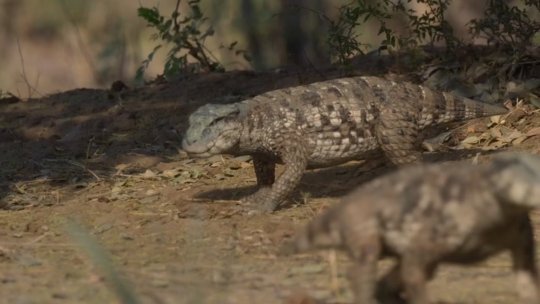
Obviously we didn't get much still, but I'll regardless post my list of candidates and ideas here, perhaps third time's the charme for a lot of these (tho for convenience I'm still ordering them by S2s episode titles). I'll also try to break them apart roughly by biome, starting with islands.
PS: I'd love to hear which crocs people would have loved to see themselves. Any on this list or stuff I didn't even mention? Let me know I'm curious.

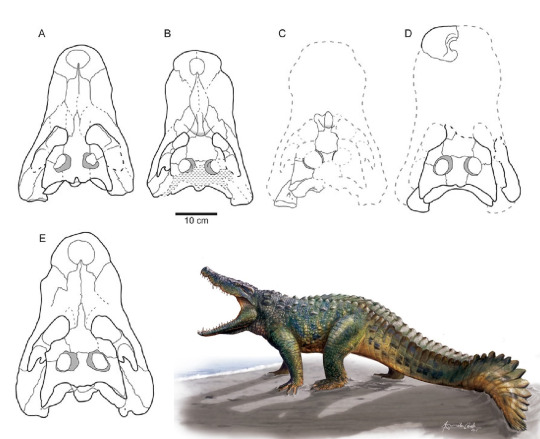

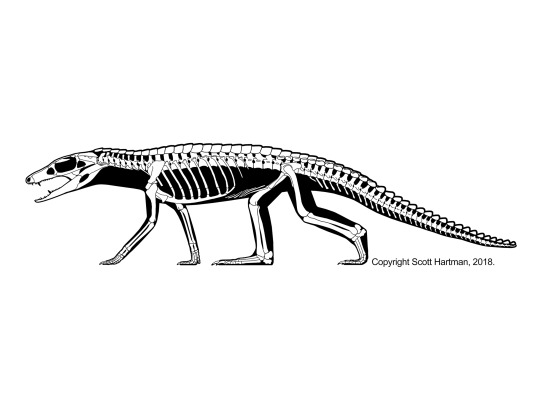

We got a shit ton of island crocs from the Cretaceous actually, which you can broadly divide into two categories.
The crocodiles of the European archipelago as seen in the top row.
Featuring the small, possibly shellfish eating Acynodon (art by Adramelech89), the incredibly widespread Allodaposuchus which did have some possibly semi-terrestrial forms (art by Alejandro Blanco, Aina and Agnès Amblás) and Aprosuchus, a tiny terrestrial critter from Hateg (art by @knuppitalism-with-ue). They already give a nice diversity between tiny durophages with blunt snouts, large, more traditional crocs and lanky land species.
The other island category concerns Madagascar, which had a lot of attention in season 2. Discounting Simosuchus, we got Araripesuchus tsangatsangana (art by Scott Hartman) and Mahajangasuchus (art by Mark Hallet). Both are really cool. The former is yet another smaller terrestrial species that may not actually be part of Araripesuchus, while the later is a massive, 4 meter relative of the famous Kaprosuchus that took to the water independently from all other crocs and has been nicknamed "Hippo croc" for its weird skull. Really I'd have loved to seen an episode entirely dedicated to this place.
Next up we had the badlands episode, which oh boy has a lot of contenders from the clade Notosuchia. Brace yourself.
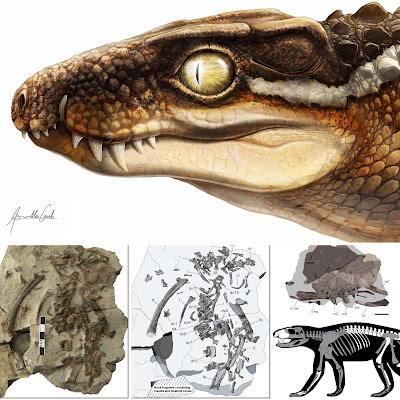


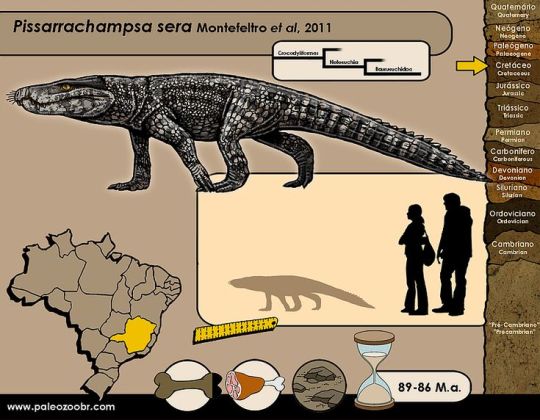


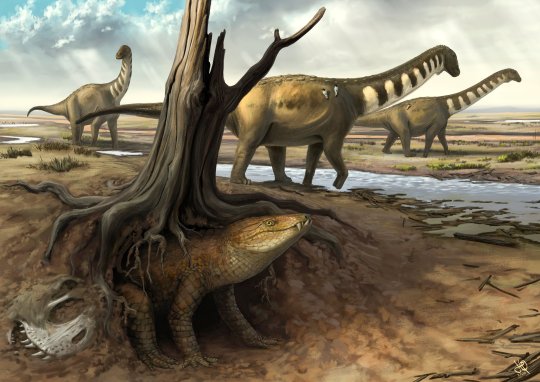

Here again I could split these in two categories.
The first is just general badland taxa. There's Ogresuchus for example, from Spain's Tremp Formation (art by Aina and Agnès Amblás). A relatively small sebecid found in a sauropod nesting site. And we all know what PhP does with baby sauropods. Or the long-necked Gobiosuchus (art by @yoofilos) from Mongolia, which may look like its related to the other ones in this category but actually is a far more ancient type of croc.
The far bigger group concerns South America's Notosuchians. ALL OF THESE are from the Bauru Group, with some even from the same single formation. You got Stratiotosuchus (again by Joschua Knüppe), a large terrestrial baurusuchid that filled the nische of mid sized carnivore in an environment shared by sauropods and abelisaurs. There's Pissarrachampsa (by Felipe Alves Elias), another baurusuchid I decided to feature because we have evidence of a nesting site that shows they only had few eggs. A great opportunity to show their tender side. Uberabasuchus (justin_an74), part of the bizzarly proportioned peirosaurids. Adamantinasuchus (by Deverson da Silva), a small, lanky Notosuchian and of course the heavily armored omnivore Armadillosuchus (by the ever talented Júlia d'Oliveira). Hell you could do a full episode just on the foodweb of the Bauru Group (Godoy et al. 2014).
Then there's swamps, which I'll just use to dump all the crocs that don't fit into the other categories.
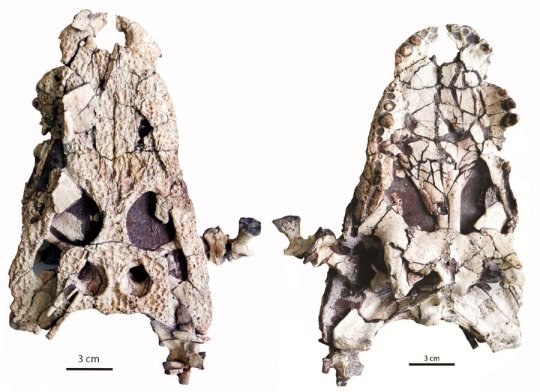


As you'd expect, freshwater would be ideal for crocs with a more traditional semi-aquatic lifestyle, here represented by three forms. Jiangxisuchus (image by Li et al. 2014) is a paralligatorid, which are tiny crocodilians from the Cretaceous and Paleogene of east Asia. We honestly don't know what they are, some say alligator relatives, others say they are closer to crocs. But its small and cute. Then there's Roxochampsa (artist of the model I couldn't find), which looks suspiciously crocodilian but is actually a relative of Uberabasuchus from the badlands, hell it appeared in the same formation. Still, I reasoned that I'd throw it into this category because I already proposed so much for badlands (none of which came true but hey). And then there's Denazinosuchus (art by Andrey Atuchin). Again it looks deceptively like a modern croc, but is actually the last remnant of the goniopholids, crocodyliforms that were prominent animals in the Jurassic and early Cretaceous. It could have brought both taxonomic diversity nad highlighted croc resilience till the end.
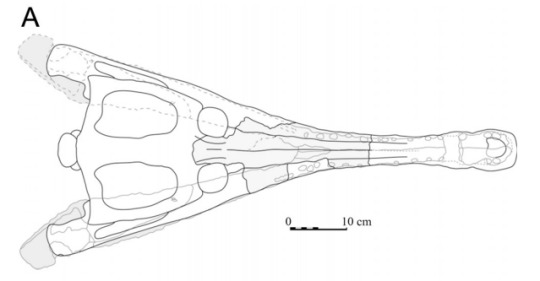

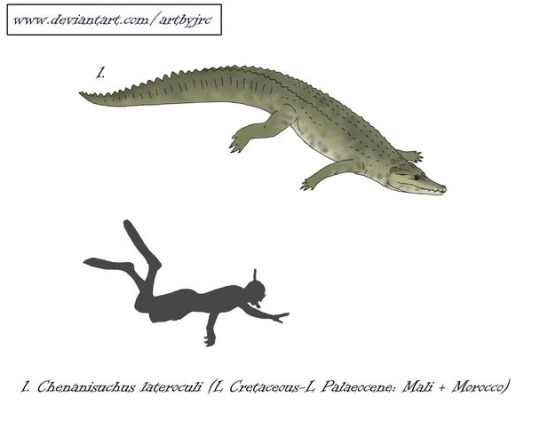
When it came to picking out crocs for Oceans, it got tricky. Obviously season 2 tried to differentiate itself by being set more in the open ocean, not the coast, and true pelagic crocodiles weren't around by the end of the Cretaceous. So I had to settle for coastal animals. There's Sabinosuchus (Schiller II et al. 2016), a cousin to Sarcosuchus and, like Denazinosuchus, one of the last of its lineage. Also its from Mexico which is rarely talked about for its fossils. Rhabdognathus (Ghedoghedo) is a distant cousin, a slender snouted dyrosaur. Unlike pholidosaurs, dyrosaurs actually did really well after the KPG impact and spread around a lot, living way into the Eocene. And finally Chenanisuchus (art by artbyjrc), which like Rhabdognathus was found both before and after the impact that killed the dinosaurs.

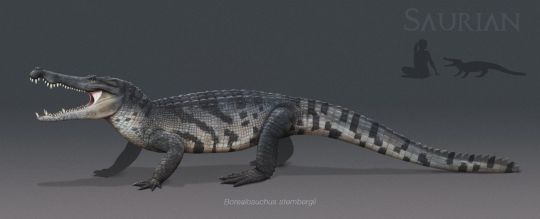
And the final two I shall talk about, both of which I thought/hoped would appear in the North America episode. Again, there's certainly overlap, both would have just as much fit into swamps, while many others would have also suited North America. Regardless, here's Brachychampsa (Tom Parker) and Borealosuchus (Chris Masna), both iconic animals from the Hell Creek Formation. One closely allied with alligators and caimans, the other more basal with a head-shape more similar to todays crocodiles.
Now obviously there'd have been a lot more. Part of the challenge to myself was to try and be as diverse as possible, rather than just listing 10 different baurusuchids I went with only two, tried to include as much of the world as possible, etc.... There's also the fact that some really awesome taxa, Titanochampsa, Brachiosuchus and Eurycephalosuchus, all incredibly unique or interesting, were published too late to have been considered for the show.
And now, in hinsight, we obviously know that with the exception of Simosuchus none of them made it in. Which is a shame, but maybe next time.
#prehistory#palaeblr#crocodile#paleontology#long post#prehistoric planet#prehistoric planet 2#borealosuchus#brachychampsa#simosuchus#pissarrachampsa#stratiotosuchus#gobiosuchus#ogresuchus#uberabasuchus#roxochampsa#armadillosuchus#adamantinasuchus#jiangxisuchus#denazinosuchus#sabinosuchus#rhabdognathus#chenanisuchus#mahajangasuchus#araripesuchus#acynodon#allodaposuchus#aprosuchus
157 notes
·
View notes
Text
Titanomachya gimenezi Pérez-Moreno et al., 2024 (new genus and species)

(Humerus [upper arm bone] of Titanomachya gimenezi [scale bar = 10 cm], from Pérez-Moreno et al., 2024)
Meaning of name: Titanomachya = for the Titanomachy [war between Olympians and Titans in Greek mythology]; gimenezi = for Olga Giménez [Argentinian paleontologist]
Age: Late Cretaceous (Maastrichtian)
Where found: La Colonia Formation, Chubut, Argentina
How much is known: Partial skeleton of one individual including several limb bones and an incomplete tail vertebra.
Notes: Titanomachya was a titanosaurian sauropod. Titanosaurs included the largest known land animals of all time, and many species are thought to have weighed well over 10 tons. Titanomachya was not so large by comparison, estimated as having weighed between 5.8–9.8 tons. However, it appears to have been more massive than some other relatively small South American titanosaurs like Saltasaurus and Neuquensaurus, which it appears to have been closely related to.
Titanomachya had a distinctive structure of its ankle compared to other titanosaurs. One of its ankle bones (the astragalus) was symmetrical, giving this bone a trapezoidal shape when viewed from the front.
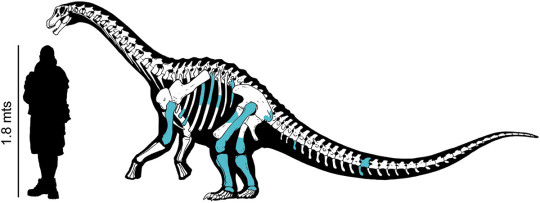
(Schematic skeletal of Titanomachya gimenezi by Gabriel Lio, with preserved bones in blue, from Pérez-Moreno et al., 2024)
Reference: Pérez-Moreno, A., L. Salgado, J.L. Carballido, A. Oter, and D. Pol. 2024. A new titanosaur from the La Colonia Formation (Campanian-Maastrichtian), Chubut Province, Argentina. Historical Biology advance online publication. doi: 10.1080/08912963.2024.2332997
76 notes
·
View notes
Text
Measuring up to four meters (13 feet) in length and weighing a ton, Gonkoken nanoi lived 72 million years ago in the extreme south of what is now Chilean Patagonia.
"These were slender-looking dinosaurs, which could easily adopt a bipedal and quadrupedal posture to reach the vegetation at height and at ground level," said Alexander Vargas, director of the paleontological network of the University of Chile and one of the authors of the study published by the journal Science Advances and presented in Santiago.
The discovery demonstrated that Chilean Patagonia served as a refuge for very ancient species of hadrosaurs, a type of duck-billed dinosaur common in North America, Asia and Europe during the Cretaceous period, from 145 to 66 million years ago.
Their presence in the remote southern lands surprised scientists, who will have to "understand how their ancestors got there," Vargas said.
Continue Reading
101 notes
·
View notes
Text
Spinosaurus.
Late Cretaceous. 99-93MYA.
It’s very possible their range extends from North Africa to the majority of South America and parts of South Asia. If they really were aquatic, they might have crossed the Atlantic to South America, which was a lot smaller at the time. This would probably make specimen like Oxalaia and Sigilmassasaurus just Spinosaurus specimen.
#video#art#my art#paleontology#paleoart#science#dinosaur#dinosaurs#theropod#spinosaurus#spinosauridae
18 notes
·
View notes
Text
Alamosaurus
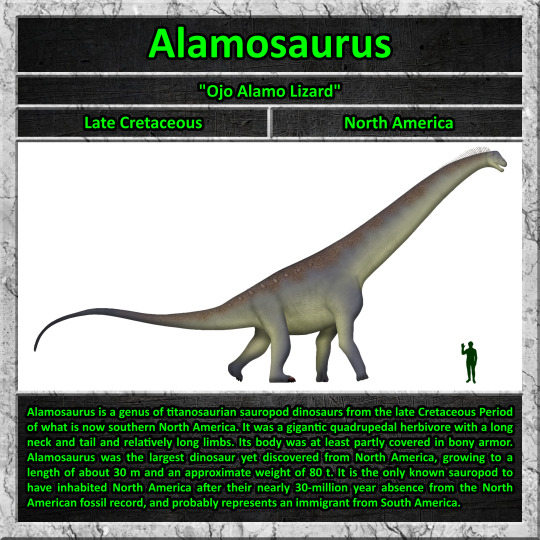
Alamosaurus is a genus of titanosaurian sauropod dinosaurs from the late Cretaceous Period of what is now southern North America. It was a gigantic quadrupedal herbivore with a long neck and tail and relatively long limbs. Its body was at least partly covered in bony armor. Alamosaurus was the largest dinosaur yet discovered from North America, growing to a length of about 30 m and an approximate weight of 80 t. It is the only known sauropod to have inhabited North America after their nearly 30-million year absence from the North American fossil record, and probably represents an immigrant from South America.
77 notes
·
View notes
Text
VOTE JAKAPIL FOR DINOSAUR MARCH MADNESS
@a-dinosaur-a-day
No other contestant in the final four is such A Creature™️ the way that Jakapil is. Jakapil is simultaneously the ultimate being to exist from the perspective of a dinosaur-obsessed child and a fascinating, paradigm-shifting paleontological enigma. Literally the perfect dinosaur, what more could you want
Why vote for Jakapil?
the most likely scenario here is that this guy represents a hundred million year old ghost lineage of basal thyreophorans that we’ve never discovered before. The less likely scenarios are bipedal armored ceratopsian or a completely new kind of ornithsician, both of which have been genuinely considered by some paleontologists! Whatever the case, Jakapil represents a brand new, never-before seen lineage of dinosaurs unlike anything we’ve ever known before, and that’s SO COOL
Aesthetically, this is a bipedal armored dinosaur with tiny abelisaur-grade arms, estimated to be less than 5 ft long and 15 lb (or 1.5 m and 7 kg max). Literally perfect. I’m really bad at visualizing measurements but I’m pretty sure you could pick it up and hold it in your arms if you tried. Sure you could do that with Heracles or Caihong, but you don’t need a Time Machine to pick up parrots and shiny bird things - there’s nothing like Jakapil for you to hold and snuggle today
They’re so friggin weird. It’s got jaws like a ceratopsian or a heterodontosaur, a jaw bone that no other basal thyreophorans have, arm anatomy shockingly similar to abelisaurs, and THEY CAN CHEW. I know that chewing seems really normal to us humans but it’s so weird to see outside of mammals. Practically the only other dinosaurs that chew are ornithopods. Jakapil seems like it’s trying to be as many kinds of dinosaur as possible, which further supports my statement that it is the Ultimate Dinosaur
It’s armored and covered in spikes. ‘Nuff said
Also a friendly reminder that the only other known bipedal thyreophoran is Scutellosaurus, which was from Early Jurassic Europe. Jakapil is from late Cretaceous South America, so this guy just popped up across the world a hundred million years later with practically no trace of its ancestors. How did this happen? What the fuck were its ancestors doing in that time? Heracles may have given us neat answers to New Zealand-y questions, but Jakapil gave us questions we didn’t even know needed to be asked
I’ve said it once and I’ve said it again, South America’s fauna has been friggin' amazing since the Cretaceous and never stopped. Automatic points for being a South American dinosaur. This guy lived alongside Giganotosaurus and Buitreraptor!!
What about the other contestants, you may ask? Kholumolumo is only here for the meme. Outside of the funny name and it’s absurdly convoluted history to getting formally named, what do you actually know about it? How much does it contribute to our understanding of dinosaurs compared to the other contestants?
Caihong is basic. I’m sorry but I won’t back down from this (for another few months at least). I love dromaeosaurs as much as the next person, but literally all that Caihong has going for it is it’s ultra-inridescence. Any other Chinese dromaeosaur could provide the rest. Look past your instinctual love of shiny things and vote for something that breaks away from everything we thought we knew to become something truly unique!
As for Heracles... I actually have nothing bad to say about Heracles, I love New Zealand's fauna and giant flightless birds (especially on islands). But while I love Heracles for everything it stands for, I feel like Jakapil stands for so much more. Heracles is a wonderful addition to our knowledge of it's lineage and environment, but also... is it really that surprising to find a giant flightless bird in New Zealand that belongs to that a family endemic to New Zealand? Jakapil is just such a bizarre, fascinating, unexpected discovery from so many perspectives. It is truly the ultimate dinosaur, and we should honor it as such
As of the time of writing there's still four days left at the polls and Jakapil is a steady second place in all three of them. We still have time to win this for Jakapil and dethrone Caihong!
#dinosaur march madness#dmm rising stars#dmm final four#dmm finals#jakapil#dmm#a-dinosaur-a-day#JAKAPIL SWEEP#long post#hmm i should probably be tagging these as long posts shouldnt i
109 notes
·
View notes
Text
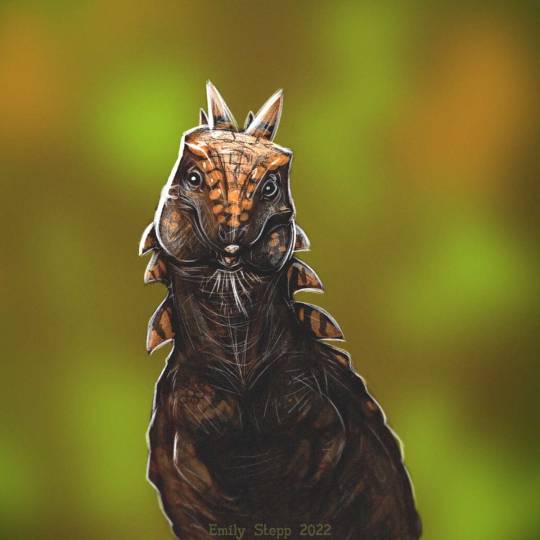
Jakapil
Jakapil — рід тиреофорових динозаврів із ранньокрейдової формації Канделерос в Аргентині. Типовим видом є Jakapil kaniukura.
Повний текст на сайті "Вимерлий світ":
https://extinctworld.in.ua/jakapil/
#jakapil#dinosaur#cretaceous#argentina#south america#paleoart#cretaceous period#art#dinosaurs#jakapil kaniukura#extinct#thyreophora#ornithischia#paleontology#daily#prehistoric#animals#prehistory#fossils#illustration#animal art#палеоарт#палеонтологія#ukraine#ukrainian#українська мова#арт#україна#мова#динозавр
82 notes
·
View notes